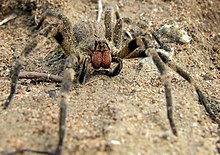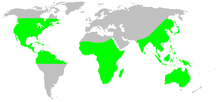Wandering spider
| Wandering spiders Temporal range: Neogene–present PreꞒ Ꞓ O S D C P T J K Pg N | |
|---|---|
 | |
| Phoneutria nigriventer | |
| Scientific classification | |
| Domain: | Eukaryota |
| Kingdom: | Animalia |
| Phylum: | Arthropoda |
| Subphylum: | Chelicerata |
| Class: | Arachnida |
| Order: | Araneae |
| Infraorder: | Araneomorphae |
| Family: | Ctenidae Keyserling, 1877 |
| Diversity | |
| 49 genera, 533 species | |
 | |
Wandering spiders (Ctenidae) are a family of spiders that includes the Brazilian wandering spiders. These spiders have a distinctive longitudinal groove on the top-rear of their oval carapace similar to those of the Amaurobiidae.[1] They are highly defensive[2] and venomous nocturnal hunters. Wandering spiders are known to hunt large prey, for example hylid species Dendropsophus branneri.[3] Despite their notoriety for being dangerous, only a few members of Phoneutria have venom known to be hazardous to humans, but the venoms of this family are poorly known,[4] so all larger ctenids should be treated with caution.
General
As of July 2021[update], the World Spider Catalog accepts the following genera:[5]
- Acantheis Thorell, 1891 — Asia
- Acanthoctenus Keyserling, 1877 — South America, Central America, Jamaica, Mexico
- Africactenus Hyatt, 1954 — Africa, India
- Afroneutria Polotow & Jocqué, 2015 — Africa
- Amauropelma Raven, Stumkat & Gray, 2001 — Asia, Australia
- Amicactenus Henrard & Jocqué, 2017 — Africa
- Anahita Karsch, 1879 — Africa, Asia, United States
- Ancylometes Bertkau, 1880 — South America, Honduras
- Apolania Simon, 1898 — Seychelles
- Arctenus Polotow & Jocqué, 2014 — Kenya
- Asthenoctenus Simon, 1897 — South America
- Bengalla Gray & Thompson, 2001 — Australia
- Bulboctenus Pereira, Labarque & Polotow, 2020 — Brazil
- Califorctenus Jiménez, Berrian, Polotow & Palacios-Cardiel, 2017
- Caloctenus Keyserling, 1877 — Ethiopia, South America
- Celaetycheus Simon, 1897 — Brazil
- Centroctenus Mello-Leitão, 1929 — South America
- Chococtenus Dupérré, 2015 — Ecuador, Colombia
- Ciba Bloom, Binford, Esposito, Alayón, Peterson, Nishida, Loubet-Senear & Agnarsson, 2014 — Cuba, Dominican Republic
- Ctenus Walckenaer, 1805 — Africa, South America, Oceania, Central America, Asia, North America, Caribbean
- Diallomus Simon, 1897 — Sri Lanka
- Enoploctenus Simon, 1897 — South America, Saint Vincent and the Grenadines
- Gephyroctenus Mello-Leitão, 1936 — Brazil, Peru
- Isoctenus Bertkau, 1880 — Brazil, Argentina
- Janusia Gray, 1973 — Australia
- Kiekie Polotow & Brescovit, 2018 — Colombia, Central America, Mexico
- Leptoctenus L. Koch, 1878 — Australia, North America, Panama
- Macroctenus Henrard & Jocqué, 2017 — Guinea
- Mahafalytenus Silva-Dávila, 2007 — Madagascar
- Montescueia Carcavallo & Martínez, 1961 — Argentina
- Nimbanahita Henrard & Jocqué, 2017 — Guinea
- Nothroctenus Badcock, 1932 — Brazil, Bolivia, Paraguay
- Ohvida Polotow & Brescovit, 2009 — Cuba
- Parabatinga Polotow & Brescovit, 2009 — South America
- Perictenus Henrard & Jocqué, 2017 — Guinea
- Petaloctenus Jocqué & Steyn, 1997 — Africa
- Phoneutria Perty, 1833 — South America
- Phymatoctenus Simon, 1897 — Brazil, Guyana, Costa Rica
- Piloctenus Henrard & Jocqué, 2017 — Guinea, Togo, Ivory Coast
- Sinoctenus Marusik, Zhang & Omelko, 2012
- Spinoctenus Hazzi, Polotow, Brescovit, González-Obando & Simó, 2018
- Thoriosa Simon, 1910 — São Tomé and Príncipe, Sierra Leone, Equatorial Guinea
- Toca Polotow & Brescovit, 2009 — Brazil
- Trogloctenus Lessert, 1935 — Congo
- Trujillina Bryant, 1948 — Caribbean
- Tuticanus Simon, 1897 — Ecuador, Peru
- Viracucha Lehtinen, 1967 — South America
- Wiedenmeyeria Schenkel, 1953 — Venezuela
See also
References
- ^ McGavin, George C. (2002). Insects and Other Terrestrial Arthropods. New York: Dorling Kindersley Ltd. p. 230. ISBN 0-7894-9392-6.
- ^ Bücherl, Wolfgang; Buckley, Eleanor E. (2013). Venomous Animals and Their Venoms: Venomous Invertebrates. Elsevier. p. 237. ISBN 978-1-4832-6289-5.
- ^ de Araujo Lira, André Felipe (May 26, 2000). "Predation of Dendropsophus branneri (Cochran, 1948) (Anura: Hylidae) by wandering spider (Araneae: Ctenidae) in an Atlantic forest remnant". Herpetology Notes. 13: 421–424 – via Biotaxa.
- ^ Okamoto; et al. (2009). "Ctenus medius and Phoneutria nigriventer spiders venoms share noxious proinflammatory activities". J. Med. Entomol. 46 (1): 58–66. doi:10.1603/033.046.0108. PMID 19198518. S2CID 33154932.
- ^ "Family: Ctenidae Keyserling, 1877". World Spider Catalog. Natural History Museum Bern. Retrieved 2012-07-08.
External links


- World Spider Catalog 8.0: Family Ctenidae
- v
- t
- e
- Kingdom: Animalia
- Phylum: Arthropoda
- Subphylum: Chelicerata
- Class: Arachnida
Suborder Mesothelae | |
|---|---|
|
Suborder Opisthothelae | |||||||||||||||
|---|---|---|---|---|---|---|---|---|---|---|---|---|---|---|---|
| |||||||||||||||
- Spider taxonomy
- Bold are families with more than 1000 species
This Ctenidae-related article is a stub. You can help Wikipedia by expanding it. |
- v
- t
- e











